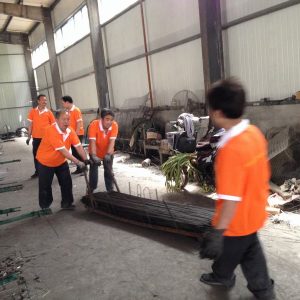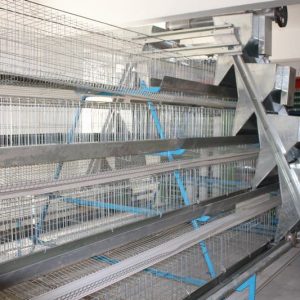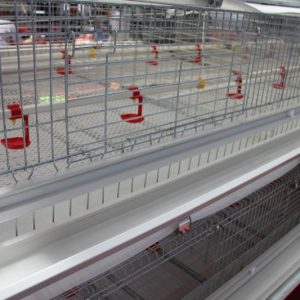
Raising technology of black chicken in old courtyard
The old courtyard black chicken is named because it is mainly produced in Jiuyuan Town, Wanyuan City. It is characterized by five blacks and one green, with black hair, skin, meat and internal organs, green eggshells, rich nutrition, and rich in lecithin that is beneficial to the human body. , Named by the Chinese Academy of Sciences: “Rare in the world, unique in China, unique in Wanyuan”, known as the source of life green food.
1. Chicken Coop Construction
The chicken coops of the old black chickens are built in a ventilated and sunny place. A 70*120 cm light-permeable window can be opened every 3 meters before and after the coop. A perch can be placed on one side of the house, and drinking fountains and troughs can be distributed at equal distances. Inside the dormitory, a small door of 160 cm high and 70 cm wide is opened on the side of the sunny side at the same time, and a playground covered with sand is set outside the door. General chicken coops are suitable for raising green-shell black chickens, and chicken coops can also use idle houses or set up simple sheds according to local conditions.
2. Incubation
Breeding eggs should be 40 grams or more each, and artificial incubation should be used. For small amounts of breeding, please incubate in the incubator on behalf of them. Key points of incubation technology: ①Temperature and humidity: The eggs should be incubated in batches at a constant temperature. Each batch of eggs should be placed at a cross interval. When entering the incubation eggs, pay attention to the big end of the eggs on the egg tray. The first day to 18 days of incubation, in the incubator (Egg surface temperature) 37.8℃ in cold weather is suitable, 37.5℃ in summer is suitable. Transfer to the hatcher on the 19th day of incubation. Pay attention to laying the eggs flat. The temperature inside the machine is 37.2℃ in cold weather and 37℃ in summer. . The relative humidity is 60% from day 1 to day 18 and 70% from day 19 to day 21. ②Turning the eggs: Turn the eggs once every two hours, at an angle of 90 degrees. ③Hatch: Generally, the hatching begins on the 20th day of hatching, and the hatching is basically completed in 21 days. ④ Disinfection: The breeding eggs must be disinfected once half an hour after laying and before hatching. After the chicks are hatched, they must be cleaned and disinfected once. Normally, spray disinfection such as formalin fumigation or Baidusha is used.
3. Nutrition and feeding
The nutritional requirements for black chickens in the old courtyard are as follows: dietary crude protein for chicks is 20%, metabolizable energy is 2850 kcal/kg, young chickens are crude protein 15%, metabolizable energy is 2750 kcal/kg, breeder crude protein is 17%, metabolizable energy is 2800 Kcal/kg. The brooding period is generally 30 days after the hull. The key during the brooding period is heat preservation. The heat preservation method is the same as other chickens. The general electric heating umbrella and underground flue are commonly used. A small amount of breeding is kept warm by infrared lamps. The temperature is around 33℃ within 3 days after the hull. Reduce 2℃ every week, the principle is to distribute the chicks evenly around the heat source. Drink water first, then start feeding, feed full price chicks all day, feed 4-6 times a day, and pay attention to ventilation during the brooding period. The density is generally 10 days old and raise 40-50 chicks per square meter, 20 days There are 30 animals, 20 animals at 30 days old, and about 10 animals per square meter after 20 weeks of age. After 30 weeks of age, use quantitative feeding to prevent premature and over-fatification. The weight of 20-week-old hens is generally controlled to be about 1.16 kg, and the weight of roosters is about 2.01 kg. Each group of breeders can raise 100 to 200, except for breeders. In addition to restricted feeding, light should be restricted if conditions permit. It is best to change to a black chicken house after 8 weeks, with 8 hours of light per day.
The requirement of light for laying eggs is 16 hours per day before the start of laying until the age of 20 weeks, and the peak laying time is 16 hours to 17.5 hours. At the age of 20 weeks, change the feed for young chickens to full-price laying and breeder feeds, add water-soluble multi-vitamins, etc. to the drinking water. Farmers can feed some vegetables or grasses. The general amount is about 20% of the total feed, but it is not mixed. Feed in dry feed. The feed consumption for laying hens is about 85 grams per day per day. Pay attention to frequently adding medium-coarse sand, and the amount is 6-7 kg per 1,000 chickens. The breeding hen house can be equipped with a laying box, a rectangular laying basin is made of wooden boards, and fine sand is placed to keep the environment quiet and dry.
4. Disease control
The disease prevention of black chickens in the old courtyard runs through the entire feeding process. The out-of-shell flocks must be injected with Marek’s vaccine. The chicks are between 1 day to 5 days old, 12 days old to 14 days old, and 35 days when they are more sick and poorly managed. To prevent bacterial diseases such as Salmonella and Escherichia coli, the first choice is enrofloxacin. Use 100 ml of 10% solution to dissolve in 100 kg of water for half a day. , Or use 10 mg per kilogram of body weight. In addition, drugs such as Tylenol and Doxycycline are used to prevent respiratory diseases such as mycoplasma and mycoplasma. It is often disinfected with disinfectant solutions such as Baidusha.
Take care to prevent coccidiosis around 3 weeks of age. From 7 days to 10 days of age, administer Newcastle disease II vaccines or drink water, and vaccinate fowlpox vaccine at the same time. From 12 days to 14 days of age, chickens should be immunized with bursal bursal vaccine for the first time. . Breeder chickens should do a good job of inoculation and prevention of inactivated oil vaccines such as Newcastle disease, bursal disease, infectious bronchitis and egg drop syndrome, which are specifically formulated according to the local chicken immunization program.


